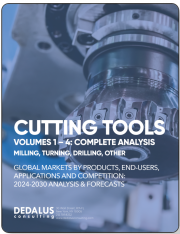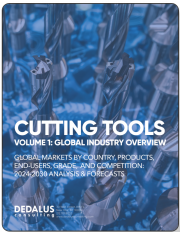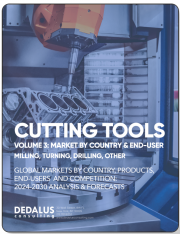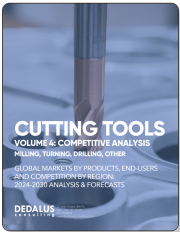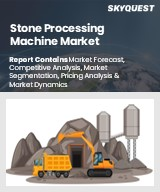
|
시장보고서
상품코드
1625247
절단 장비 시장 예측(-2030년) : 제품별, 재료별, 동력원별, 조작 모드별, 유통 채널별, 최종사용자별, 지역별 세계 분석Cutting Equipment Market Forecasts to 2030 - Global Analysis By Product, Material, Power Source, Operation Mode, Distribution Channel, End User and By Geography |
||||||
Stratistics MRC에 따르면 세계의 절단 장비 시장은 2024년에 54억 6,000만 달러를 차지하며 예측 기간 중 CAGR 11.5%로 성장하며, 2030년에는 88억 4,000만 달러에 달할 전망입니다.
절단 장비는 재료를 정확하게 절단, 성형 및 분리하도록 설계된 툴 및 기계를 말합니다. 이러한 장비는 제조, 건설, 금속 가공 및 기타 산업에서 사용됩니다. 일반적인 유형에는 톱, 레이저, 플라즈마 커터, 워터젯, 전단 등이 있으며, 각각 금속, 목재, 플라스틱과 같은 특정 재료에 적합합니다. 절단 장비는 효율성, 정확성 및 깨끗한 마무리를 보장하며 종종 자동 작동을 위해 CNC(컴퓨터 수치 제어)와 같은 첨단 기술을 통합합니다. 이는 맞춤형 형상을 만들거나 추가 가공을 위해 원료를 준비하는 데 필수적입니다.
제조업의 성장
제조업과 자동차, 항공우주, 건설 등의 산업이 성장하고 생산 규모가 커질수록 품질과 생산성 기준을 충족하기 위해 최첨단 기계가 필요합니다. 레이저 절단기 및 플라즈마 절단기와 같은 절단 장비의 기술 발전은 자동화 및 스마트 제조의 추진과 일치합니다. 또한 지속가능한 관행의 부상으로 에너지 효율적이고 환경 친화적인 절단 솔루션의 채택이 증가하고 있습니다. 산업화가 진행되는 신흥 시장에서는 신뢰할 수 있는 절단 기술에 대한 요구가 더욱 커지고 있습니다. 전반적으로 제조업 붐은 파급효과를 일으켜 절단 장비 산업에 대한 투자와 기술 혁신을 촉진하고 있습니다.
유지보수 및 운영 비용
레이저 절단기나 CNC 시스템과 같은 첨단 절단기는 정기적인 유지보수가 필요하고, 숙련된 기술자와 전문 부품이 필요하므로 비용이 많이 듭니다. 또한 에너지 소비, 절삭 공구 및 가스 등 소모품을 포함한 운영 비용은 최종사용자, 특히 중소기업에 더 많은 부담을 안겨줍니다. 이러한 경제적 부담은 도입률 감소와 다운타임 증가로 이어져 전반적인 생산성에 영향을 미칩니다. 또한 예상치 못한 수리 및 장비 고장으로 인해 업무가 중단되고 총소유비용이 증가하게 됩니다. 그 결과, 많은 산업에서 업그레이드를 늦추거나 비용 효율적인 대체 솔루션을 찾게 되고, 이는 절단 장비 시장의 성장을 제한하게 됩니다.
맞춤형 수요
자동차, 항공우주 및 제조 산업은 특정 설계 및 생산 요구 사항을 충족하기 위해 정밀하고 맞춤화된 절단을 점점 더 많이 요구하고 있습니다. 이러한 추세는 복잡하고 정확한 결과를 제공할 수 있는 CNC 기계, 레이저 커터 및 플라즈마 시스템에 대한 수요 급증으로 이어지고 있습니다. 커스터마이징은 또한 소프트웨어 및 자동화 분야의 혁신을 촉진하여 더 나은 제어와 운영 효율을 가능하게 합니다. 또한 맞춤형 제품 생산 능력은 경쟁력을 강화하여 기업이 최첨단 절단 장비에 투자하도록 유도합니다. 전반적으로 커스터마이징은 진화하는 소비자와 산업계의 취향에 맞게 장비의 능력을 조정하여 시장 성장을 가속합니다.
기술의 노후화
기술적 진부화는 새로운 기술이 등장하고 기존 장비가 속도, 정확성 및 에너지 효율에 대한 기대치를 충족시킬 수 없을 때 발생합니다. 이러한 경우 기업은 업그레이드에 많은 투자를 하거나 전체 장비 라인을 교체해야 합니다. 또한 최신 기능과 혁신을 통합하지 못하면 시장 경쟁력이 떨어질 수 있습니다. 또한 노후화된 장비는 유지보수가 필요하고 운영비용이 높아져 수익성에 영향을 미치는 경우가 많습니다. 따라서 절삭 장비 분야의 기업은 관련성을 유지하고 진부화를 피하기 위해 지속적으로 기술 혁신을 수행해야 합니다.
COVID-19의 영향
COVID-19는 절단기 시장에 큰 혼란을 일으켜 공급망, 생산 일정 및 수요 패턴에 영향을 미쳤습니다. 가동 중단 및 제한으로 인해 제조 및 프로젝트 일정이 지연되고, 산업 활동 및 설비 투자 감소로 인해 장비 수요가 감소했습니다. 그러나 의료, 식품, 포장 등 주요 부문이 정밀 절삭 공구에 대한 수요를 유지하면서 시장이 회복세를 보였습니다. 노동력 부족과 안전에 대한 우려로 인해 자동화 및 디지털 솔루션으로의 전환이 가속화되어 절삭 기술 혁신이 가속화되었습니다. 팬데믹 이후 회복세는 효율성과 지속가능성을 위해 첨단 절삭 장비에 대한 투자 증가로 두드러집니다.
예측 기간 중 철강 부문이 가장 큰 비중을 차지할 것으로 예상됩니다.
철강 부문은 건설 및 제조와 같은 산업에서 주요 재료이기 때문에 유리한 성장을 보일 것으로 예상됩니다. 철강은 광범위하게 사용되므로 부품 제작을 위해 정밀한 절단이 필요하며, 이는 첨단 절단 기술에 대한 수요를 촉진하고 있습니다. 구조용 빔에서 복잡한 부품에 이르기까지 철강의 용도는 매우 다양하므로 제조업체는 효율적이고 다용도한 절단 장비를 채택해야 합니다. 세계 인프라 프로젝트와 산업 활동 증가는 이러한 수요를 더욱 증가시키고 있습니다. 또한 고강도 철강의 발전으로 인해 정밀도와 내구성이 강화된 절삭 공구가 필요하게 되었고, 이는 절삭 장비 시장의 혁신과 성장을 지속적으로 촉진하고 있습니다.
광업 분야는 예측 기간 중 가장 높은 CAGR을 나타낼 것으로 예상됩니다.
광업 분야는 열악한 환경에서 높은 정밀도와 내구성에 대한 수요가 높아 예측 기간 중 가장 높은 CAGR 성장을 보일 것으로 예상됩니다. 채굴 작업에는 드릴링, 발파, 광물 추출과 같은 작업에 고급 절삭 공구가 필요합니다. 암석과 금속을 포함한 다양한 재료를 처리하기 위한 효율적인 장비의 필요성이 특수 절삭 솔루션에 대한 수요를 증가시키고 있습니다. 또한 채굴 작업의 자동화와 디지털화로 인해 스마트 절단 장비와 로봇 절단 장비의 채택이 증가하고 있습니다. 결국, 광산 부문은 신뢰할 수 있는 고성능 절단 장비에 의존하고 있으며, 이는 절단 장비 시장을 주도하는 데 있으며, 매우 중요한 역할을 하고 있습니다.
가장 큰 점유율을 차지하는 지역
아시아태평양은 급속한 산업화, 도시화, 제조업의 확대로 인해 예측 기간 중 가장 큰 시장 점유율을 차지할 것으로 예상됩니다. 자동차, 항공우주, 건설, 전자 등 주요 산업이 첨단 절삭 공구 및 기계에 대한 수요를 촉진하고 있습니다. 자동화 및 정밀 절삭 솔루션과 같은 기술 발전은 효율성과 생산성을 향상시켜 시장 도입을 더욱 촉진하고 있습니다. 중국, 인도, 일본과 같은 주요 경제 국가들은 인프라 및 산업 개발에 대한 투자 증가에 힘입어 이 지역의 성장을 주도하고 있습니다.
CAGR이 가장 높은 지역 :
북미는 기술 발전과 자동차, 항공우주, 건설 등의 산업 수요 증가로 인해 예측 기간 중 가장 높은 CAGR을 나타낼 것으로 예상됩니다. 자동차, 항공우주, 건설, 조선 등 주요 산업은 플라즈마, 레이저, 워터젯 기술을 포함한 혁신적인 절단 솔루션에 대한 수요를 촉진하고 있습니다. 이 지역은 탄탄한 제조거점, 인더스트리 4.0 도입 확대, 에너지 효율이 높은 고성능 장비에 대한 집중적인 투자로 혜택을 누리고 있습니다. 인프라 및 기술 혁신에 대한 투자가 확대되고 있는 가운데, 이 시장은 세계 및 지역내 주요 장비 제조업체의 존재에 힘입어 꾸준한 성장세를 이어갈 수 있는 여건을 갖추고 있습니다.
무료 커스터마이징 서비스
이 보고서를 구독하는 고객은 다음과 같은 무료 맞춤화 옵션 중 하나를 사용할 수 있습니다. :
- 기업 개요
- 추가 시장 기업 종합 프로파일링(최대 3사)
- 주요 기업의 SWOT 분석(최대 3사)
- 지역 세분화
- 고객의 관심에 따른 주요 국가별 시장 추정치, 예측, CAGR(주: 타당성 확인에 따라 다름)
- 경쟁사 벤치마킹
- 제품 포트폴리오, 지역적 입지, 전략적 제휴를 기반으로 한 주요 기업 벤치마킹
목차
제1장 개요
제2장 서문
- 개요
- 이해관계자
- 조사 범위
- 조사 방법
- 데이터 마이닝
- 데이터 분석
- 데이터 검증
- 조사 어프로치
- 조사 정보원
- 1차 조사 정보원
- 2차 조사 정보원
- 전제조건
제3장 시장 동향 분석
- 촉진요인
- 억제요인
- 기회
- 위협
- 제품 분석
- 최종사용자 분석
- 신흥 시장
- COVID-19의 영향
제4장 Porter's Five Forces 분석
- 공급 기업의 교섭력
- 바이어의 교섭력
- 대체품의 위협
- 신규 진출업체의 위협
- 경쟁 기업 간 경쟁 관계
제5장 세계의 절단 장비 시장 : 제품별
- 수동 절단 장비
- 반자동 절단 장비
- 전자동 절단 장비
제6장 세계의 절단 장비 시장 : 재료별
- 금속
- 강철
- 알루미늄
- 비금속
- 유리
- 플라스틱
- 세라믹
- 복합재료
제7장 세계의 절단 장비 시장 : 동력원별
- 전동 구동
- 가솔린 구동
- 유압 구동
- 기타 동력원
제8장 세계의 절단 장비 시장 : 조작 모드별
- 핸드헬드 커팅 머신
- CNC 절단기
제9장 세계의 절단 장비 시장 : 유통 채널별
- 직접 판매
- 판매 대리점
- 온라인 채널
제10장 세계의 절단 장비 시장 : 최종사용자별
- 산업 기기 제조
- 조선
- 석유 및 가스
- 광업
- 소비재
- 기타 최종사용자
제11장 세계의 절단 장비 시장 : 지역별
- 북미
- 미국
- 캐나다
- 멕시코
- 유럽
- 독일
- 영국
- 이탈리아
- 프랑스
- 스페인
- 기타 유럽
- 아시아태평양
- 일본
- 중국
- 인도
- 호주
- 뉴질랜드
- 한국
- 기타 아시아태평양
- 남미
- 아르헨티나
- 브라질
- 칠레
- 기타 남미
- 중동 및 아프리카
- 사우디아라비아
- 아랍에미리트
- 카타르
- 남아프리카공화국
- 기타 중동 및 아프리카
제12장 주요 발전
- 계약, 파트너십, 협업, 합병사업
- 인수와 합병
- 신제품 발매
- 사업 확대
- 기타 주요 전략
제13장 기업 프로파일링
- Lincoln Electric Holdings, Inc.
- Colfax Corporation
- Illinois Tool Works Inc.(ITW)
- Air Liquide
- Messer Group
- Koike Aronson, Inc.
- Hypertherm, Inc.
- Ador Welding Limited
- Komatsu Ltd.
- TRUMPF Group
- Hobart Brothers LLC
- Linde plc
- Amada Co., Ltd.
- Bystronic Group
According to Stratistics MRC, the Global Cutting Equipment Market is accounted for $5.46 billion in 2024 and is expected to reach $8.84 billion by 2030 growing at a CAGR of 11.5% during the forecast period. Cutting equipment refers to tools or machines designed to cut, shape, or separate materials with precision. These devices are used across industries like manufacturing, construction, and metalworking. Common types include saws, lasers, plasma cutters, water jets, and shears, each suited for specific materials like metal, wood, or plastic. Cutting equipment ensures efficiency, accuracy, and clean finishes, often incorporating advanced technologies like CNC (computer numerical control) for automated operations. They are essential for creating custom shapes or preparing raw materials for further processing.
Market Dynamics:
Driver:
Growth in manufacturing sector
The growth of the manufacturing sector and industries like automotive, aerospace, and construction scale production, they require cutting-edge machinery to meet quality and productivity standards. Technological advancements in cutting equipment, such as laser and plasma cutters, align with the sector's push for automation and smart manufacturing. Additionally, the rise of sustainable practices encourages the adoption of energy-efficient and eco-friendly cutting solutions. Emerging markets, with increasing industrialization, further amplify the need for reliable cutting technologies. Overall, the manufacturing boom creates a ripple effect, boosting investments and innovation in the cutting equipment industry.
Restraint:
Maintenance and operational costs
Advanced cutting machines, such as laser cutters and CNC systems, require regular servicing, which demands skilled technicians and specialized parts, driving up expenses. Additionally, operational costs, including energy consumption and consumables like cutting tools or gases, further burden end-users, particularly small and medium enterprises. These financial strains can lead to reduced adoption rates and increased downtime, impacting overall productivity. Moreover, unforeseen repairs or equipment breakdowns disrupt operations, adding to the total cost of ownership. Consequently, many industries delay upgrades or seek alternative, cost-effective solutions, limiting the cutting equipment market's expansion.
Opportunity:
Customization demand
Industries such as automotive, aerospace, and manufacturing increasingly require precise, tailored cuts to meet specific design and production needs. This trend has led to a surge in demand for CNC machines, laser cutters, and plasma systems capable of delivering intricate and accurate results. Customization also fuels innovation in software and automation, enabling better control and efficiency in operations. Furthermore, the ability to produce bespoke products enhances competitiveness, compelling businesses to invest in state-of-the-art cutting equipment. Overall, customization drives market growth by aligning equipment capabilities with evolving consumer and industrial preferences.
Threat:
Technological obsolescence
Technological obsolescence occurs when new technologies arise and existing equipment is unable to fulfil the expectations for speed, precision, and energy efficiency. These forces companies to either invest heavily in upgrades or replace their entire equipment line. The inability to integrate modern features or innovations can also lead to decreased competitiveness in the market. Moreover, obsolete equipment often requires more maintenance and incurs higher operational costs, impacting profitability. Consequently, businesses in the cutting equipment sector must continuously innovate to stay relevant and avoid obsolescence.
Covid-19 Impact
The COVID-19 pandemic significantly disrupted the cutting equipment market, impacting supply chains, production schedules, and demand patterns. Lockdowns and restrictions led to delays in manufacturing and project timelines, while reduced industrial activity and capital expenditure lowered equipment demand. However, the market witnessed resilience as essential sectors like healthcare, food, and packaging maintained demand for precision cutting tools. The shift toward automation and digital solutions, driven by labor shortages and safety concerns, accelerated innovation in cutting technology. Post-pandemic recovery is marked by increasing investments in advanced cutting equipment for efficiency and sustainability.
The steel segment is expected to be the largest during the forecast period
The steel segment is estimated to have a lucrative growth, by being a primary material in industries like construction and manufacturing. Its extensive use requires precise cutting for creating components, fuelling demand for advanced cutting technologies. Steel's diverse applications, from structural beams to intricate parts, push manufacturers to adopt efficient and versatile cutting equipment. The rise in global infrastructure projects and industrial activities further amplifies this demand. Additionally, advancements in high-strength steels necessitate cutting tools with enhanced precision and durability, continues to propel innovation and growth in the cutting equipment market.
The mining segment is expected to have the highest CAGR during the forecast period
The mining segment is anticipated to witness the highest CAGR growth during the forecast period, due to its high demand for precision and durability in harsh environments. Mining operations require advanced cutting tools for tasks such as drilling, blasting, and mineral extraction. The need for efficient equipment to handle various materials, including rocks and metals, boosts the demand for specialized cutting solutions. Additionally, automation and digitalization in mining operations have increased the adoption of smart and robotic cutting equipment. Ultimately, the mining segment's reliance on reliable and high-performance cutting equipment ensures its pivotal role in propelling the cutting equipment market.
Region with largest share:
Asia Pacific is expected to hold the largest market share during the forecast period due to rapid industrialization, urbanization, and expanding manufacturing sectors. Key industries such as automotive, aerospace, construction and electronics are fuelling demand for advanced cutting tools and machinery. Technological advancements, including automation and precision cutting solutions, are enhancing efficiency and productivity, further boosting market adoption. Major economies like China, India, and Japan lead the region's growth, supported by increasing investments in infrastructure and industrial development.
Region with highest CAGR:
North America is expected to have the highest CAGR over the forecast period, driven by advancements in technology and rising demand across industries such as automotive, aerospace, and construction. Key industries such as automotive, aerospace, construction and shipbuilding are fuelling demand for innovative cutting solutions, including plasma, laser, and water jet technologies. The region benefits from a strong manufacturing base, increasing adoption of Industry 4.0, and a focus on energy-efficient and high-performance equipment. With growing investments in infrastructure and technological innovation, the market is poised for steady growth, supported by the presence of major global and regional equipment manufacturers.
Key players in the market
Some of the key players profiled in the Cutting Equipment Market include Lincoln Electric Holdings, Inc., Colfax Corporation, Illinois Tool Works Inc. (ITW), Air Liquide, Messer Group, Koike Aronson, Inc., Hypertherm, Inc., Ador Welding Limited, Komatsu Ltd., TRUMPF Group, Hobart Brothers LLC, Linde plc, Amada Co., Ltd. and Bystronic Group.
Key Developments:
In December 2024, Colfax entered into a binding agreement to acquire Victor Technologies, which includes the assumption of debt. This acquisition aims to enhance Colfax's Fabrication Technology Platform and expand its ESAB business's product portfolio into new segments.
In November 2024, ITW EAE announced a partnership with Foster Innovative Technology (FIT), which will represent ITW EAE's equipment in several states including Colorado, Idaho, Oregon, Montana, Utah, Washington, and Wyoming. This collaboration aims to enhance ITW's market reach and customer service in these regions.
In April 2024, Lincoln Electric acquired RedViking, an automation system integrator based in Plymouth, Michigan. This acquisition enhances Lincoln Electric's portfolio in automation solutions, particularly in the aerospace and defense sectors.
Products Covered:
- Manual Cutting Equipment
- Semi-Automated Cutting Equipment
- Fully Automated Cutting Equipment
Materials Covered:
- Metal
- Non-Metal
Power Sources Covered:
- Electric-Powered
- Gas-Powered
- Hydraulic-Powered
- Other Power Sources
Operation Modes Covered:
- Handheld Cutting Machines
- CNC Cutting Machines
Distribution Channels Covered:
- Direct Sales
- Distributors
- Online Channels
End Users Covered:
- Industrial Equipment Manufacturing
- Shipbuilding
- Oil & Gas
- Mining
- Consumer Goods
- Other End Users
Regions Covered:
- North America
- US
- Canada
- Mexico
- Europe
- Germany
- UK
- Italy
- France
- Spain
- Rest of Europe
- Asia Pacific
- Japan
- China
- India
- Australia
- New Zealand
- South Korea
- Rest of Asia Pacific
- South America
- Argentina
- Brazil
- Chile
- Rest of South America
- Middle East & Africa
- Saudi Arabia
- UAE
- Qatar
- South Africa
- Rest of Middle East & Africa
What our report offers:
- Market share assessments for the regional and country-level segments
- Strategic recommendations for the new entrants
- Covers Market data for the years 2022, 2023, 2024, 2026, and 2030
- Market Trends (Drivers, Constraints, Opportunities, Threats, Challenges, Investment Opportunities, and recommendations)
- Strategic recommendations in key business segments based on the market estimations
- Competitive landscaping mapping the key common trends
- Company profiling with detailed strategies, financials, and recent developments
- Supply chain trends mapping the latest technological advancements
Free Customization Offerings:
All the customers of this report will be entitled to receive one of the following free customization options:
- Company Profiling
- Comprehensive profiling of additional market players (up to 3)
- SWOT Analysis of key players (up to 3)
- Regional Segmentation
- Market estimations, Forecasts and CAGR of any prominent country as per the client's interest (Note: Depends on feasibility check)
- Competitive Benchmarking
- Benchmarking of key players based on product portfolio, geographical presence, and strategic alliances
Table of Contents
1 Executive Summary
2 Preface
- 2.1 Abstract
- 2.2 Stake Holders
- 2.3 Research Scope
- 2.4 Research Methodology
- 2.4.1 Data Mining
- 2.4.2 Data Analysis
- 2.4.3 Data Validation
- 2.4.4 Research Approach
- 2.5 Research Sources
- 2.5.1 Primary Research Sources
- 2.5.2 Secondary Research Sources
- 2.5.3 Assumptions
3 Market Trend Analysis
- 3.1 Introduction
- 3.2 Drivers
- 3.3 Restraints
- 3.4 Opportunities
- 3.5 Threats
- 3.6 Product Analysis
- 3.7 End User Analysis
- 3.8 Emerging Markets
- 3.9 Impact of Covid-19
4 Porters Five Force Analysis
- 4.1 Bargaining power of suppliers
- 4.2 Bargaining power of buyers
- 4.3 Threat of substitutes
- 4.4 Threat of new entrants
- 4.5 Competitive rivalry
5 Global Cutting Equipment Market, By Product
- 5.1 Introduction
- 5.2 Manual Cutting Equipment
- 5.3 Semi-Automated Cutting Equipment
- 5.4 Fully Automated Cutting Equipment
6 Global Cutting Equipment Market, By Material
- 6.1 Introduction
- 6.2 Metal
- 6.2.1 Steel
- 6.2.2 Aluminum
- 6.3 Non-Metal
- 6.3.1 Glass
- 6.3.2 Plastics
- 6.3.3 Ceramics
- 6.3.4 Composites
7 Global Cutting Equipment Market, By Power Source
- 7.1 Introduction
- 7.2 Electric-Powered
- 7.3 Gas-Powered
- 7.4 Hydraulic-Powered
- 7.5 Other Power Sources
8 Global Cutting Equipment Market, By Operation Mode
- 8.1 Introduction
- 8.2 Handheld Cutting Machines
- 8.3 CNC Cutting Machines
9 Global Cutting Equipment Market, By Distribution Channel
- 9.1 Introduction
- 9.2 Direct Sales
- 9.3 Distributors
- 9.4 Online Channels
10 Global Cutting Equipment Market, By End User
- 10.1 Introduction
- 10.2 Industrial Equipment Manufacturing
- 10.3 Shipbuilding
- 10.4 Oil & Gas
- 10.5 Mining
- 10.6 Consumer Goods
- 10.7 Other End Users
11 Global Cutting Equipment Market, By Geography
- 11.1 Introduction
- 11.2 North America
- 11.2.1 US
- 11.2.2 Canada
- 11.2.3 Mexico
- 11.3 Europe
- 11.3.1 Germany
- 11.3.2 UK
- 11.3.3 Italy
- 11.3.4 France
- 11.3.5 Spain
- 11.3.6 Rest of Europe
- 11.4 Asia Pacific
- 11.4.1 Japan
- 11.4.2 China
- 11.4.3 India
- 11.4.4 Australia
- 11.4.5 New Zealand
- 11.4.6 South Korea
- 11.4.7 Rest of Asia Pacific
- 11.5 South America
- 11.5.1 Argentina
- 11.5.2 Brazil
- 11.5.3 Chile
- 11.5.4 Rest of South America
- 11.6 Middle East & Africa
- 11.6.1 Saudi Arabia
- 11.6.2 UAE
- 11.6.3 Qatar
- 11.6.4 South Africa
- 11.6.5 Rest of Middle East & Africa
12 Key Developments
- 12.1 Agreements, Partnerships, Collaborations and Joint Ventures
- 12.2 Acquisitions & Mergers
- 12.3 New Product Launch
- 12.4 Expansions
- 12.5 Other Key Strategies
13 Company Profiling
- 13.1 Lincoln Electric Holdings, Inc.
- 13.2 Colfax Corporation
- 13.3 Illinois Tool Works Inc. (ITW)
- 13.4 Air Liquide
- 13.5 Messer Group
- 13.6 Koike Aronson, Inc.
- 13.7 Hypertherm, Inc.
- 13.8 Ador Welding Limited
- 13.9 Komatsu Ltd.
- 13.10 TRUMPF Group
- 13.11 Hobart Brothers LLC
- 13.12 Linde plc
- 13.13 Amada Co., Ltd.
- 13.14 Bystronic Group






